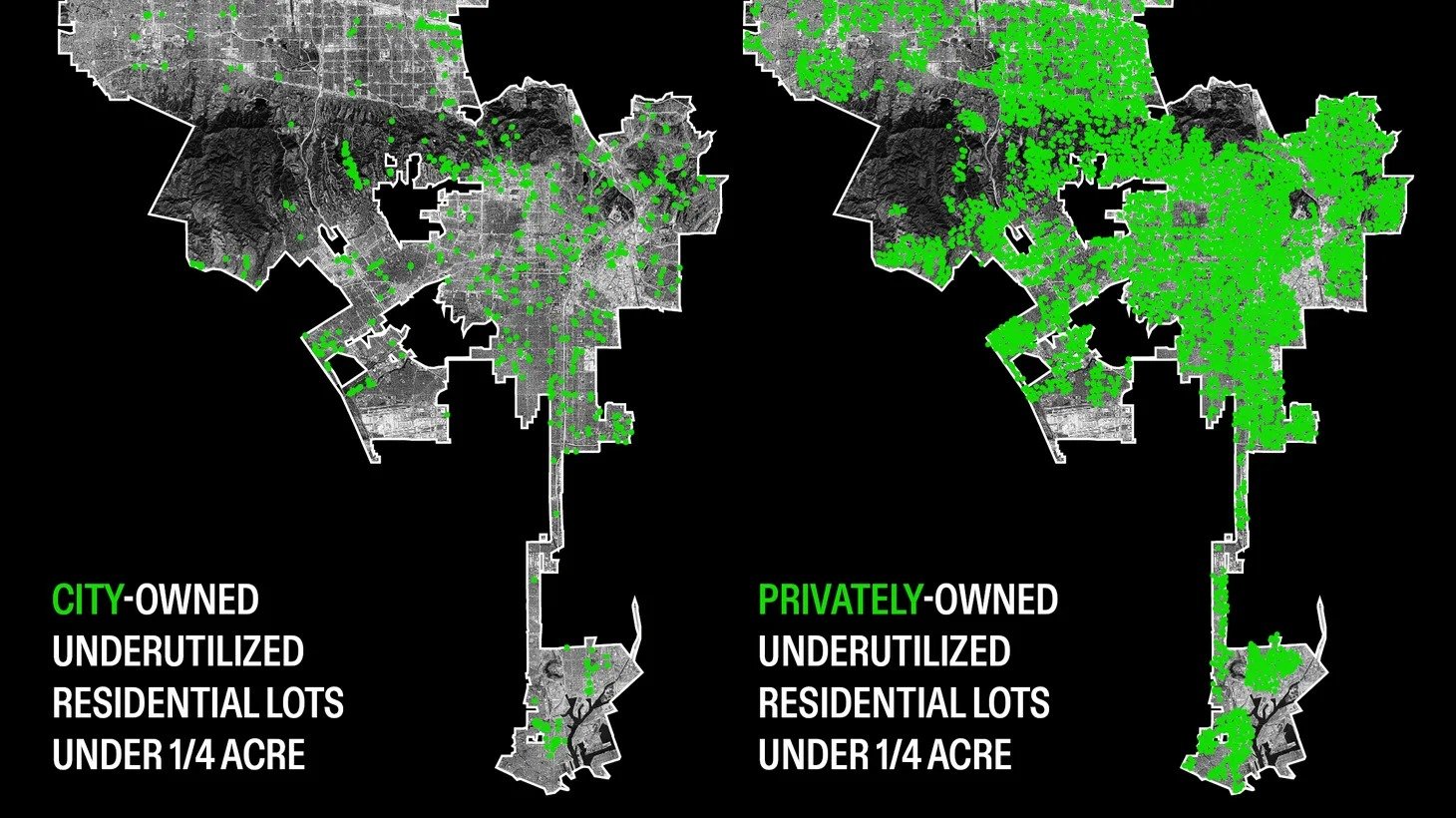
Paloma Dooley, Home Under Power, 2019. Courtesy of the Artist.
News
Los Angeles launches effort to encourage starter homes on city-owned vacant lots
“Angelenos should be able to buy their first home and raise their families in our city,” Los Angeles Mayor Karen Bass said in a statement. “The launch of Small Lots, Big Impacts is a step toward that future.”
Cuff said she hopes the design competition and subsequent building on city lots will show developers they can make money doing the same thing on land that’s now privately owned. She also hopes it will show the general public that Los Angeles doesn’t have to rely on skyscrapers to grow.
“These projects I think will really demonstrate that living together, with slightly more households on a site, is going to be a pretty nice arrangement,” Cuff said.
cityLAB-UCLA competition challenges architects to jumpstart Los Angeles’s housing market by utilizing small, forgotten lots
Small Lots, Big Impact—a new architecture competition hosted by the City of Los Angeles, LA4LA, and cityLAB-UCLA—could yield more new buildings like the ones Ruscha celebrated, helping plug a stifling housing crisis recent wildfires have only made more pronounced.
For Cuff, Small Lots, Big Impact is as much about generating good architectural form as well as challenging real estate developers to get creative and generate new ownership models, changing the status quo. “A lot of this has to do with changing development culture,” Cuff noted. She said this can happen by exploring concepts like “gentle density,” and “staying power,” which encourages multi-generational living inside good, compact housing.
What’s the model for building starter homes on small LA lots?
“The NIMBY [not in my backyard] interests are around larger developments than this. We're really looking at gentle density,” Cuff says. “And … it's not as if people don't want two units on their site or four units next door. They want some stability, in a sense that people have an ownership role in their neighborhoods. Frankly, most neighborhoods now have multiple ADUs [accessory dwelling units], so there's already gentle density getting added. … I'm always optimistic about these things, but I'm hoping that these models that we're doing through the Small Lots, Big Impacts initiative will really remove the fear that people have of more neighbors on the sites next door to them.”
New initiative to design innovative starter homes on vacant land launches
“We need to see what’s possible for L.A.’s near future,” said Dana Cuff, director of cityLAB at UCLA. “By bringing together the best architects, developers and builders, we can invent a new generation of ‘SoCal starter homes’ — compact, sharing land once occupied by a single house (and) giving dignity and joy to their residents while respecting Mother Nature.”
DESIGN AND ARCHITECTURE Newsletter
Small Lots, Low Impact brings to mind the city’s Low Rise Housing Challenge, organized some five years ago by then Chief Design Officer Christopher Hawthorne, that produced some very creative housing and housing ownership options, in anticipation of the passage of SB9 and 10, which legalized the addition of several units and even subdivision on some single-family lots.
A big difference, says Cuff, is that the Challenge produced some great ideas; this new competition is intended to lead to tangible, viewable buildings on actual lots. cityLAB has unearthed 24,000 vacant residential lots of which about 1,000 are owned by the city. It will sell off about 10 of them. They are also meant to test new ownership models like Tenants-In-Common or other collective options, and open up the chance at development to a new generation of local investors and designers.
Competition insights: Dana Cuff on Los Angeles’ Small Lots, Big lmpacts contest
We’d like to see submissions that focus on community at two scales: at the scale of the buildings themselves and at the scale of the neighbourhood. Especially in the face of an increasingly volatile climate, building housing that fosters community connections will be paramount.
New L.A. competition targets small lots to address the city's housing crisis
A one-of-its-kind design initiative from the City of Los Angeles and the UCLA AUD’s cityLAB is asking participants to imagine innovative starter home designs that can be developed on small and vacant lots. The Small Lots, Big Impacts challenge is kicking off this week and will result in the approvals of transferable plans to be used by developers in the future.
Small Lots, Big Impact: How Architects and Developers Can Unlock L.A.’s Hidden Housing Potential
The conversation around housing in Los Angeles is shifting. While large-scale apartment developments remain a critical piece of the puzzle, they aren’t the only solution. By utilizing small, fragmented lots, L.A. can create a network of new housing that blends into existing neighborhoods while adding much-needed density. For architects, designers, and developers, Small Lots, Big Impact represents more than a competition — it’s a chance to reshape the fabric of Los Angeles, one forgotten lot at a time.



















